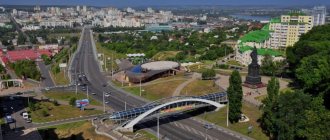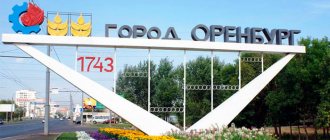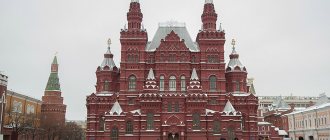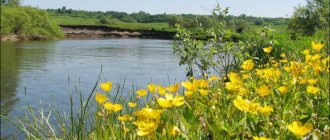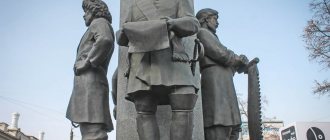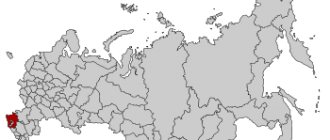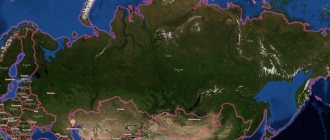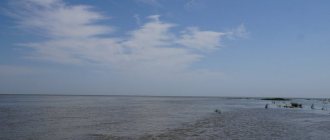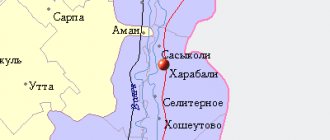Founded: 1558
White City - the historical part of Astrakhan
Astrakhan
- a Russian city, the center of the Astrakhan region, located on 11 islands of the Caspian lowland, in the upper part of the Volga delta.
The settlement that was on the site of Astrakhan had different names at different times: Astarkhan, Ashtarkhan, Khadzhi-Tarkhan
. There is an opinion that near the modern territory of Astrakhan there was also the famous Itil, the capital of Khazaria.
Its convenient position for trade at the crossroads of routes from Persia and India to the Russian principalities and Europe made the city a tasty prey for neighboring states. The settlement was destroyed several times, but always not completely; the winner always needed a trading platform. The first written mention of the city dates back to 1333.
An Arab traveler writes about the city as the autumn residence of the Khan of the Golden Horde. In 1395 the city was destroyed by Tamerlane. And in 1456, Astrakhan became the capital of the Astrakhan Khanate. In 1556, Ivan the Terrible annexed the Astrakhan Khanate to Russia, and in 1558 the city was moved to a new location. Construction of the Russian fortress in 1558
in the new place is considered to be
the date of the founding
of modern Astrakhan.
At the beginning of the 17th century, Astrakhan was plundered by both Don and Terek Cossacks. In 1670, residents of Astrakhan supported Stepan Razin. Astrakhan received city status under Peter I.
At the end of the 19th century, due to the development of oil fields in Baku, the Astrakhan port became one of the largest in the country. Astrakhan is famous for its fisheries and the best beluga, stellate sturgeon and sturgeon caviar.
During the Great Patriotic War, the front was 150 km from the city. During the war, Astrakhan was an important transshipment point for fuel and lubricants from the Caucasus towards central Russia; many hospitals were concentrated in the city.
In the post-war years, industry developed in the city. Nowadays, with the development of international trade on the Caspian Sea, the importance of Astrakhan as a transport hub is growing.
Assumption Cathedral and the bell tower of the Prechistensky Gate
Astrakhan is famous
for its many bridges spanning rivers and eriks. The Astrakhan Kremlin is magnificent. In the center of the former White City, the farmsteads of oriental merchants, mosques, and the Roman Catholic Church of the Assumption of the Virgin Mary have been preserved. Interesting art gallery named after. B.M. Kustodiev and the historical and architectural museum-reserve, famous for its collection of historical monuments of the Khazars and the Golden Horde.
In the vicinity of the city, tourists are attracted by the salt lake Baskunchak and the highest relief element in the Caspian lowland - Mount Bolshoye Bogdo; 20 caves are known in the mountain area, the largest of which reaches 1.5 km.
Interesting Facts
The Astrakhan Catholic Church was the third most founded Catholic church in Russia (after St. Petersburg and Moscow). The Astrakhan Kremlin is depicted on a commemorative ruble coin.
More than 530 thousand people live in the city (2014).
Day of the city
in Astrakhan it is celebrated in the fall.
History of Astrakhan
The Bulgarian historian and writer Vasyl Kush, in a historical collection of 1542, indicates that from 179 BC. Until 1122, the Barsyl Bulgars lived on the territory of modern Astrakhan, that is, already from the 2nd century BC. this area was inhabited.
It is also known that in the 8th–10th centuries, not far from modern Astrakhan, upstream the Volga, there was the city of Itil, the capital of a large medieval state. Its inhabitants, the Khazars, often raided Russian lands, and in 965, the Kiev prince Svyatoslav launched a military campaign and defeated the Khazar state, capturing their capital.
In the 13th century, Mongol-Tatar tribes came to the Astrakhan lands from the east and founded the settlement of Hadji-Tarkhan in the lower reaches of the Volga, not far from the former Khazar capital.
Astrakhan
What do you need to do during your vacation in Astrakhan in order to feel the flavor of this southern city? We have prepared for you a list of things that are definitely worth doing while vacationing in Astrakhan.
Kremlin walls
© Maxim Starostin
- Climb the Kremlin walls . In the towers of the Astrakhan Kremlin there are exhibitions related to the history of the city. An observation deck with loopholes through which you can look at the city is located in the Red Gate entrance tower. She is also the tallest. You can also view Astrakhan from above by climbing the cathedral bell tower of the Kremlin.
- Take a boat ride along the Volga . The navigation season in Astrakhan begins in late April-early May and lasts until October. Pleasure boats depart from Petrovskaya Embankment around Gorodskaya Island - for one and an hour and a half.
- Walk along Kirov Street . The historical street crosses the central district of Bely Gorod and is pedestrian in the section from Sovetskaya to Esplanadnaya. Kirov is called the “Astrakhan Arbat” - on summer evenings a cheerful and creative atmosphere reigns here.
- Ride a camel. Centuries ago, loaded caravans from Central Asia and the Middle East came to the city. Do you want to plunge into the flavor of a medieval trading city from the Golden Horde era? Head to Saray-Batu, a recreated scenery of the ancient city. And exploring the city and the surrounding steppes is much more colorful - riding a camel.
Camel in "Saray-Batu"© Alexey Panin
- Eat watermelon . Be sure to spoon it on the beach - locals say it tastes much better this way. The watermelon season in Astrakhan begins in August. Choose the loudest watermelon on the market and go on a picnic.
- Try Astrakhan fish and black caviar . Smoked or dried sturgeon and sturgeon caviar can be tasted right at the market. Sturgeon dishes are available in city restaurants. Instead of a classic fish steak, order something exotic: pasties with sturgeon or smoked carp ribs.
- Go fishing . The most delicious fish is freshly caught with your own hands. If you have never fished on your own, it is worth going fishing with the locals. There are many fishing bases in the Volga delta. This is one of the richest places in Russia in terms of diverse catches. In the Astrakhan region you can catch sturgeon, beluga, sterlet, giant catfish and carp.
- Buy a fish skin souvenir . Astrakhan craftsmen produce shoes, wallets, belts and passport covers from processed Caspian fish leather.
- Listen to the singing of the mountains . In the Akhtubinsky district there is a unique mountain - Big Bogdo. The mountain grows by 1 mm every year and “sings”. The unusual effect of singing arises due to the relief: during the existence of the mountain, the steppe wind “carved” hundreds of holes, craters and caves in the mountain. Passing through the holes, the air produces sounds similar to a hum.
Guide
There is no single tourist route combining the attractions of Astrakhan. Tourists are guided by personal interest and the time allocated to explore the city. Cruise ship passengers are usually limited to walking around the historical center for a few hours. We offer you several routes in different parts of Astrakhan; if desired, they can be combined into one large route.
Route 1: White City
The White City of Astrakhan is the historical center of the city, located on an artificial nameless island, which is bounded by the Volga, the rivers Kutum and Tsarev, as well as the Varvatsia Canal. The basis of the historical buildings of the White City are low-rise stone houses built in pre-revolutionary times. A walk around the White City takes several hours. But, with visiting all the museums, such a route can take a full day.
Swan Lake
© Vladimir Shalaev
- Annunciation Monastery . The ancient monastery of the 17th century with white stone walls is enough to examine from the outside.
- Sovetskaya street . On one of the main streets of the city there are estates and mansions of the late 19th and early 20th centuries. You will see the building of the provincial government, the Mariinsky gymnasium, the drama theater and the three-story apartment building of Bagirov.
- Astrakhan Kremlin . After passing through the cozy green Brotherly Garden, you will come out to the walls of the Astrakhan Kremlin. Explore ancient cathedrals and towers, climb the Kremlin walls and, if you have time, visit one of the Kremlin museums.
- Swan Lake . Next, move towards the Volga. Pass by picturesque Swan Lake with a rotunda in the center of the reservoir. The Astrakhan Planetarium is also located here.
- Triumphal Arch . The restored Arc de Triomphe is a tribute to the memory of the previous wooden arch, built for the arrival of Emperor Alexander II in Astrakhan. The baroque arch made of granite and marble is decorated with bas-reliefs depicting historical events that took place in Astrakhan.
Acquaintance with the central island of Astrakhan ends with walks along the embankments - Petrovskaya along the city branch of the Volga and Krasnaya along the Kutum river. At the end of the day, you can visit one of the city markets and try Astrakhan specialties.
Route 2: Slobody
A less popular, but more colorful route runs on the other side of the Varvatsia Canal. In the historical settlements, bounded by the Varvatsia Canal and Bakinskaya Street, the historical buildings of past centuries have also been preserved. But, unlike the White City, the houses here are wooden. Merchants and other people associated with trade lived in the settlements.
In the ancient settlements of Astrakhan
© grau59
Start your walk from the Kriusha quarter with private low-rise houses built before the revolution. Next, go to the Morskaya Sloboda quarter, where fishermen previously lived. The next block along the route is Armenian Settlement. In addition to charming wooden houses, the Armenian Church of St. Hripsime, a German church and the Azerbaijani Baki Mosque are located here. In the Persian Sloboda quarter there are few traces left of the life of Persian merchants. Among the notable buildings here are Mamajanov's house and Agababov's estate.
Further along the route there is the Agryzhanskaya Sloboda quarter, where the descendants of the marriages of Indian merchants with Tatar women lived. The main attraction of the settlement is the Red Mosque (Central Mosque No. 1), built at the end of the 19th century. The largest historical district, Tatarskaya Sloboda, is notable for its mosques. On its territory there is the oldest mosque in the city - the White, as well as the Black and Nogai mosques.
At the end of the route, it is worth going beyond the historical settlements and visiting 2 Orthodox churches: the Church of St. John Chrysostom and the Vladimir Cathedral.
In detail: What to see in Astrakhan in 1 day 2 days
3 days
Event tourism
In Astrakhan, the cultures of East and West, ancient traditions of nomadic peoples and modern culture intertwine. Astrakhan and the region host a large number of cultural events, ethnic festivals and holidays dedicated to the culture and traditions of the peoples of the Southern Volga and Caspian regions. What events are worth visiting while vacationing in Astrakhan?
International Festival of Vocal Art named after. V. Barsova and M. Maksakova takes place in Astrakhan in April. The festival is dedicated to classical music and opera. During the festival days, you can attend performances by artists of the Mariinsky Theater or listen to concerts of national orchestras from other countries.
The Vobla Festival is an annual fishing festival that has been taking place in Astrakhan since 1997. The festival takes place at the end of April, when huge schools of roach come from the Caspian Sea to the lower reaches of the Volga. The main part of the festival is a competition among amateur fishermen for the biggest catch.
Fisherman's Day in Astrakhan is one of the favorite holidays of the townspeople. It is celebrated on July 12th. On the Volga embankment, entertainment events and an exhibition of folk crafts are held, guests are treated to traditional fish soup and other fish dishes. The holiday ends with a concert of invited stars and fireworks.
The international festival of musical culture "Golden Horde" is celebrated on the territory of the cultural and historical complex "Sarai-Batu". As part of the festival, a reconstruction of “Bunchuk Batu” is held: archery competitions, sword fights and mass battles are held. Guests can try on the armor of a Mongol warrior and try the ethnic dishes of nomads.
Sand sculpture at the festival “Dreams of the Dunes”
© Alexey Panin
Watermelon Day takes place in Astrakhan in September. The holiday is held in the form of a colorful fair, where guests can take part in master classes on carving (artistic watermelon carving) and watermelon eating competitions. The festival offers tastings of different varieties of watermelon - with green and orange pulp, as well as watermelon and melon desserts and cocktails.
The All-Russian camel races for the prize of the Minister of Agriculture of the Russian Federation are the only camel races in our country. At the competitions you can not only watch this unusual spectacle, but also ride a camel yourself. Guests can also enjoy horse-drawn carriage rides and festive festivities.
The Fish and Geek festival is a popular event among young people. The festival, dedicated to cosplay and geek culture, is the largest festival of this type in the south of Russia. “Fish and Geek” takes place at the Zeichgauz museum and exhibition complex in October. Guests can visit interactive art zones based on popular video games and films, get acquainted with the achievements of robotics, watch reconstructions and performances by directors, artists and other geek stars.
The Delta Jazz festival takes place on the large and small stages of the Astrakhan State Opera and Ballet Theater. The program includes performances by musical jazz groups from Russia, Italy, the USA and other countries. The jazz festival in Astrakhan is held in mid-October.
The “Dreams of the Dunes” festival is held on the territory of the Sarai-Batu complex in mid-August. The main event of the festival is the sand sculpture competition. In the surroundings of an ancient city in the middle of the sands, the sculptures look especially authentic. Also, as part of the “Dream of the Dunes”, military-historical reconstructions, musical performances and an open-air concert until the morning are held.
The International Festival of Contemporary Art "Caspian" introduces guests and residents of Astrakhan to the musical creations of contemporary composers from regions of Russia and other countries. The festival is held at the Astrakhan Philharmonic in October.
Seasonal holidays
The climate of Astrakhan is not always favorable for travel. However, Astrakhan is charming in different ways in different seasons. Nature and attractions open up from new sides if you look at them in the off-season.
Winter
Astrakhan in winter
© miljkovic14
The weather in Astrakhan in the winter months is very unstable - frosts down to -30 degrees can descend on the city and last for 1-2 weeks, or thaws with above-zero temperatures may come. What to do at this time in Astrakhan? One of the favorite pastimes of the townspeople is ice skating on frozen canals and Swan Lake. In case of a thaw, the largest indoor skating rinks are located in the “Three Cats” shopping center and in the entertainment center. A traditional pastime for Astrakhan residents is horseback riding. This is a special type of sled that is made from a piece of wood with a soft seat and old hockey skates. People ride chunks on their knees and push off with a pair of metal rods. In winter, there are even comic competitions called “Chuni-Muni” held on Swan Lake.
Winter fishing is another popular activity among tourists in Astrakhan. Rivers and lakes in the region usually do not freeze until mid-December. Therefore, ice fishing is fun in the second half of winter.
Spring
At the beginning of spring, there may be frosts in Astrakhan, and sometimes strong winds blow. But by mid-April the weather is sunny and warm. This is the best time to travel to Astrakhan. The city is surrounded by flowering gardens; you can have picnics on the embankment with the first strawberries. In the vicinity of Astrakhan, the steppe begins to bloom - a stunningly beautiful sight. During the May holidays, the navigation season begins in Astrakhan - you can go on boat trips along the Volga within the region and beyond.
Blooms in Astrakhan Plan your vacation in Astrakhan not only in accordance with the calendar of events and weather conditions. Pay attention to the natural blooms - Astrakhan is an amazingly beautiful region. In the second half of April, tulips bloom in the Astrakhan steppes, poppies bloom abundantly and colorfully in May, June is the flowering season for cacti, and from the second half of July until the end of August, lotuses bloom in the Volga delta.
Summer
Astrakhan in summer
© Maxim Starostin
The hot Astrakhan summer is a time of festivals, fresh fruit and boating on the Volga delta. Despite the fact that it is in the Astrakhan region that the Volga flows into the Caspian Sea, there are no classic seaside beaches here. The confluence, the so-called seaside, is reed thickets, lotus fields and channels with huge water lilies. Agree, this looks much more exotic than the usual beach doing nothing at a resort? Therefore, the first thing tourists do on a country holiday in the Astrakhan region is rent a boat with a local ranger and go to explore the nature of the Volga delta. Sailing along the channels, you will see herons and swans, how ornamental chilim and reeds grow, you will pass through lotus fields and arches of willow branches. Don’t forget your swimsuit: in the wild places of the seaside, swimming is a special pleasure.
You can also swim in Astrakhan. Basically, these are the sandy banks of the Volga and its tributaries. The main beach is located on the eastern side of Gorodsky Island, opposite the central part of Astrakhan. Other popular beaches in the area: in the villages of Assadulaevo and Rassvet, as well as on the spit in the village of Sovetsky. The beach season in Astrakhan begins in June and lasts until the end of summer. True, in some reservoirs you can swim only until the end of July - in August, fresh water blooms. In June and early July, a beach holiday can be overshadowed by mosquitoes and midges - there are a lot of them in the Volga delta. The best month for summer holidays in Astrakhan is August - watermelon season.
More about the beaches of Astrakhan
Autumn
Autumn Astrakhan
© Dmitry Traveler
The first half of autumn is a mild and warm time. Autumn is equally suitable for excursions around the city and for trips around the Astrakhan region. In September and October, the city hosts many festivals and celebrations, with markets filled with sweet watermelons and melons, vegetables and fruits.
During the November holidays in Astrakhan, frosts and rainy weather with piercing winds are possible. This time is suitable for exploring the city's museum collections and theaters. And on warm days you can still get out into nature - the Volga delta, falling asleep towards winter, with rare birds during this period looks enchanting and very poetic.
Fishing
Fishing in Astrakhan is one of the main tourism brands in the region. This activity attracts thousands of fans from other regions of Russia and even from abroad all year round. Despite the fact that a decent catch is practically guaranteed at any time of the year, fishing in Astrakhan and the region has its own characteristics in different months.
Fishermen in Astrakhan
© Igor Butyrskii
In the winter months, when there is no ice on the reservoirs, carp bite well, and during ice fishing, perch and pike bite well. Also caught in winter are rudd, roach, saberfish and silver bream. The ice begins to fall in mid-December and lasts until the 20th of February. Spring fishing in Astrakhan is divided into 3 periods. From mid-March to the last week of April pike perch, asp, perch, roach and pike bite. The bite is excellent - even beginners can boast of a rich catch. In the last week of April, high water begins due to discharges from the Volzhskaya hydroelectric station - the bite worsens. From mid-May until the 20th of June, fishing is possible only in special fishing areas.
June fishing is overshadowed by the abundance of midges. In June, the Caspian herring season begins, and predatory fish actively bite. Hot July is a great time to catch pike perch, catfish and asp. On the riffles, sabrefish go well. August is the most popular month for holidays in Astrakhan. Because of this, the fishing bases are crowded, and accommodation costs more than in other months.
In September, predatory fish are caught; among the “peaceful” underwater inhabitants, tench bite well. Foggy October is great for catching pike perch, carp and asp. November with drizzly rains is the best time to catch walleye. The catch this month is literally crazy.
Where to catch sturgeon in the Astrakhan region? All individuals of the sturgeon family are listed in the International Red Book. Official sturgeon hunting is permitted only in special reservoirs for a fee. But even paid fishing is possible only at a strictly designated time and under certain favorable conditions. Catching sturgeon is prohibited at night and during the spawning season.
There are many recreation centers for fishermen in the region. Most of them offer rental equipment, boats and huntsman services. The most budget options with a minimum level of comfort will cost 500 rubles per day. There are full-fledged guest houses with a bedroom, kitchen and bathhouse. The cost of such accommodation facilities starts from several thousand.
Party places
Petrovskaya embankment in the evening
© acvazul-v2010
The Kosa district is considered the most party place in Astrakhan. This is a piece of land that emerged from under the water due to a change in the course of the Volga at the end of the 18th century. The center of city parties is Fioletova Street. The best bar on Fioletova is considered to be the “Cult Bar” or, simply, “Cult”. Next door, on Ulyanov Street, is the Dublin bar, which serves shots with caramel vodka for only 50 rubles per shot. The best craft beer and burgers are served at Escobar.
“Jet Set” is a bar with original cocktails and a club summer area for open-air dancing. People come to Chicago House to dance and listen to quality music - it is considered the club with the best sound in the city. Here you can also have dinner and sing karaoke in a separate room. The Lost World resto club is considered one of the most elite establishments in Astrakhan. The Sixth Element nightclub is part of a large entertainment complex with bowling, billiards and a cinema.
Cultural recreation in open areas
© acvazul-v2010
On summer evenings, concerts and dance events take place in the city's open areas. The Opera House organizes the Music on the Grass festival. Concerts are being held on Swan Lake as part of the “Music on the Water” project from the Astrakhan Philharmonic. On the Krasnaya and Petrovskaya embankments, concerts of Astrakhan musical groups and invited stars are held in the evenings throughout the summer. Open-air film screenings take place on Lenin Square on Friday evenings. The city’s theaters also open summer stages: the Drama Theater gives performances as part of the “Theater in the Garden” project, and the Youth Theater opens the “Theater Kaleidoscope” project in the art courtyard of the Kremlin. Lovers of fine art can visit the museum courtyard of the Astrakhan Art Gallery.
Art objects
Art objects from the Chilim festival are one of the main informal attractions of Astrakhan. As part of the festival, young artists decorate the nondescript walls of Astrakhan houses with creative graffiti. The most remarkable objects of street art in Astrakhan:
- “Personification” is the image of a modern Turgenev girl: the girl’s portrait consists of quotes from Turgenev’s works. There is a portrait on the house on Turgenev Street, 2.
- A theater curtain with Pasternak peeking out from behind it (a reference to the poem “Hamlet”) is painted on the wall near the Drama Theater. Exact address: intersection of st. Lenina, 25/1 and Sovetskaya, 28/1.
- “Interweaving” - an abstract drawing decorates the wall of the dormitory of the Astrakhan Medical Academy. Drawings by the same author in the same style can be seen in other cities of Russia and, while traveling, you can collect a collection of photos.
- On the territory of the destroyed Spaso-Preobrazhensky Monastery there is graffiti with a monastery guarded by an angel.
Street art lovers should also visit Tsoi's wall on Teatralny Lane. The old transformer booth at the intersection of Kirov and Shaumyan is remarkably painted - a caricature of wall advertising that spoils the appearance of the city.
Vacation with children
© Maxim Starostin
The unusual nature and fabulous architecture delight adults and children alike. The white-stone Kremlin with the golden domes of the churches on the island reminds children of the fairy tale about Tsar Saltan, and the wooden towers and stone mansions seem like a portal to the past. The color is added by neighborhoods with wooden galleries and lively southern courtyards. But you shouldn’t limit yourself to just walking around the city. There are many places in Astrakhan and its surroundings that are worth visiting with children.
In the local history museum, children are especially interested in looking at stuffed huge Astrakhan fish. And the Moulage Museum is entirely dedicated to frogs and toads. At the house-museum of Velimir Khlebnikov there is a children's project “Veranda of Fairy Tales”, introducing the work of the poet.
The only Ferris wheel in the city is located in Planet Park. There you can ride carousels, catamarans or jump on trampolines. On a bad day, you can visit the entertainment center with trampolines and labyrinths. At the Golden Club water park you can ride open-air slides, swim in pools and participate in entertainment events with an animator.
Wildlife of the Astrakhan region
© Elena Senina
The Baba Frosya Zoo is located in the village of Ivanchug. This is a very cozy place where animals live in spacious enclosures and pens. On an area of 2 hectares you will see: lions, leopards, hyenas, brown bears, raccoons, steppe foxes, raccoon dogs, buffalos, camels, llamas, birds of prey and waterfowl. In summer, there is an aqua zone with swimming pools on site. There are also areas for fishermen and gazebos with barbecues.
The Astrakhan Biosphere Reserve is worth a visit to see animals in their natural habitat. In the Volga delta you can see giant pink pelicans and Caspian seals, and in the steppe part of the reserve - antelopes and saigas. There are routes visiting the Lotus Valley and the Cordon tract with cacti.
Detailed material: Holidays with children in Astrakhan
Astrakhan under the Golden Horde
The settlement was located on the right bank of the Volga, 12 kilometers from modern Astrakhan and was called Ashtarkhan or Adzhitarkhan, according to other sources - Khadzhi Tarkhan. During the heyday of the Golden Horde, the city was the largest international trade center, where merchants from many countries gathered, crafts developed here, and pottery, blacksmith and copper foundries worked here.
In 1395, Khan Tokhtamysh, ruling at that time, came into conflict with the conqueror of Central Asian lands, Tamerlane (Timur). The cruel and cunning Emir Tamerlane plundered and burned many Horde cities, including the capital of the Golden Horde, Sarai Batu, as well as the city of Hadji Tarkhan, the future Astrakhan. After this campaign, many cities of the Volga region never recovered from the devastation until the final collapse of the Golden Horde.
Popular message topics
- Monitor
A monitor is a computer output device that displays graphic information and text. The monitor consists of a screen, power supply, electronic circuit, buttons for setting screen and housing parameters, - Viruses
All living things in nature are continuously attacked by microorganisms that affect the standard of living. These are bacteria, microbes, viruses and other parasites. From a positive influence, the general condition of the body improves, and from a negative influence, on the contrary, - Incandescent lamp (history)
As you know, the incandescent lamp was invented by Thomas Edison, but we should not forget that before him it took the efforts and research of many other brilliant scientists. At the beginning of the 19th century, an English chemist named Humphry Davy invented
Khanate of Astrakhan
Unlike other settlements, Astrakhan quickly recovered after the defeat, this is explained by the fact that the city’s residents were engaged in nomadic cattle breeding and sedentary farming and therefore could feed themselves.
In 1459–1460, the Astrakhan Khanate was formed, which was headed by Mahmud Khan, brother of the Khan of the Great Horde Akhmad, and later by his son Kasim.
At this time, the city lost its significance as an important trading point between Europe and Asia. Often the occupation of the residents, led by their khan, was the robbery of passing ships. This is evidenced by the stories of the Russian traveler Afanasy Nikitin and the Venetian ambassador Ambrose Contarini, who passed through Astrakhan when returning from Persia.
A. Contarini recalled that he miraculously escaped slavery; he also wrote that the Astrakhan khans wander with all their people on the plains of Circassia and near Azov, reaching the borders of Russia, and live in the city only in winter.
Every year, a caravan with fabrics and other goods was sent from the Khanate to Russia, which were exchanged there for furs and saddles, swords and other things.
The Astrakhan Khanate existed for about 100 years and during this time it never achieved power. Astrakhan also remained a poor city, consisting mainly of dugouts.
The khan's power here was weaker than in other Horde states; it was constantly dependent on the Great Horde, and after its collapse, on the Crimean Khanate.
In turn, the Moscow governors also sought to take the Astrakhan Khanate under their control.
Geographical location of Astrakhan
Astrakhan is located in the semi-desert zone of the Caspian lowland. The territory of the city stretches for more than 45 kilometers along the banks of the Volga. Astrakhan is often compared to Venice or St. Petersburg, since the city is located on 11 islands. The terrain is flat and consists mainly of steppes.
The climate in Astrakhan is sharply continental: severe winters, during which frosts are replaced by short thaws, and sultry, dry summers. Astrakhan has more than two hundred sunny days a year.
Annexation of Astrakhan to Russia
For Moscow rulers, the subjugation of Astrakhan would mean taking control of the Volga trade route, access to the Caspian Sea and further to the east.
In 1554, two years after the capture of Kazan, Tsar Ivan the Terrible sent three militias to Astrakhan; in total, an army of 30,000 people went to the lower reaches of the Volga on ships.
The vanguard of the advanced militia defeated the Astrakhan detachment they encountered and captured prisoners. Then Russian troops took the city without a fight and expelled the protege of the Crimean Khan. Khan Dervish-Ali was placed on the throne, from whom they took an oath of allegiance to the Russian ruler.
The new khan remained to rule the city under the supervision of two Moscow governors and their military detachment. However, soon Dervish-Ali was accused of treason, he went over to the side of the Crimean Khan and killed the princes loyal to the Russian Tsar.
Then an army was sent to Astrakhan and in August 1556 the last Astrakhan khan fled the city, the Khanate was liquidated, and its territory was included in Russia. The entire population, including princes and murzas, sheikhs and “the whole mob,” took an oath of allegiance to the king.
As eyewitnesses of those events wrote, the governors “distributed the islands and arable lands in the old way and ordered yasak to be paid in the old way, as they paid the previous kings, and the princes sent them from themselves so that the sovereign would not hand them over to the Crimea and Nogai and commit servitude in his own country.”
Astrakhan today
Today, the once small city, which gained fame as a “fishing” capital, is rightfully considered an important strategic transport hub, river and sea port, industrial and cultural center of the Lower Volga region.
However, this was not always the case. In post-Soviet times, Astrakhan lost some of its former greatness: fishing decreased, production stopped, and agriculture fell into decay.
Anyone who can compare today's Astrakhan with the city of those years has only one association - the city is coming to life. Many political and cultural figures have repeatedly noted the qualitative rise of Astrakhan and predicted its fate as a direct competitor in its beauty and amenities to such cities as Moscow, Kazan and St. Petersburg.
Astrakhan fortress
After Astrakhan and its districts were annexed to the Moscow state, Russia gained access to the Caspian Sea, and the city was to become an important outpost in the southeast of the country.
Since Astrakhan was located on the right bank of the Volga and did not have fortifications or natural defenses, governor Ivan Cheremisinov founded a fortress on Zayachiy (Dolgy) Island in 1558.
The need for such strengthening was also explained by the city’s remoteness from Moscow, from which it was impossible to quickly receive help.
According to the English envoy A. Jenkinson, who visited the city during his travels in 1558–1563, “the city of Astrakhan is located on an island, on a high bank, inside the city there is a Kremlin, surrounded by a wooden and earthen wall, both ugly and fragile.”
The Astrakhan Kremlin was like this for about 30 years. In 1569, the Turkish Sultan and the Crimean Khan launched a campaign against the city. The Kremlin withstood the siege of the Crimean-Turkish army, and in 1580 repelled the offensive of the Crimean-Nogai horde.
Despite this, the construction of a stone Kremlin soon began. It is known that stones from destroyed buildings in the city of Sarai Batu, the former capital of the Golden Horde, were used in its construction.
In plan, the Astrakhan fortress had the shape of an irregular triangle and was located on an island, so that the water approached directly to its walls.
The structure had 8 towers, on top of which were wooden tents and watchtowers. Most of the loopholes were intended for handguns. The walls of the new fortification reached a height of 20 meters and their thickness was five meters.
Of the eight towers, three were travel gates; their gates were called Red, Nikolsky and Prechistensky.
The Astrakhan Kremlin became even more impenetrable in the 30s of the 17th century, when the second row of stone fortifications, called the White City, was built.
Due to the remoteness of Astrakhan, its Kremlin often suffered from forces opposing the Moscow government.
- So, in 1613, under Tsar Mikhail Fedorovich Romanov, Ataman Ivan Zarutsky and Marina Mnishek, participants in the Don Troubles, took refuge here. They tried to stir up the Cossacks and Nogai Tatars against Tsar Mikhail, and also to drag Persia and Turkey into the war with Russia. To suppress the unrest in the south of Russia in the spring of 1614, government troops were sent to Astrakhan and the fleeing Zarutsky and Marina were captured on the banks of the Yaik River
- In 1670, Astrakhan was captured almost without a fight by Stepan Razin, who carried out a real massacre of the governor, nobles, centurions and boyars. The city was under the rule of the rebels for almost 17 months and only after the execution of Stepan Razin in the fall of 1671 the city was liberated by government troops
- In 1705–1706, the Astrakhan Kremlin was captured by detachments of soldiers and archers who did not want to carry out the decree of Peter I regarding the ban on wearing Russian dress and beards. A detachment led by Field Marshal Boris Petrovich Sheremetev stormed the fortress and the movement was suppressed.
From Astrakhan in 1722, Peter the Great made his campaign to Persia.
But gradually the Astrakhan Kremlin is losing its military significance and remains only a monument of history and culture.
What is famous for the city of Astrakhan in Russia?
Remembering Astrakhan, what immediately comes to mind is that this city occupied one of the key places during the Golden Horde. But the city on 11 islands is famous not only for this .
For example, natives of Astrakhan are Vasily Tatishchev (politician and historian), Boris Kustodiev (artist who paints in the “realism” and “modern” styles), Nadezhda Babkina (folk singer), Yuri Tatarinov (biochemist), Dmitry Dyuzhev (modern theater and film actor), Andrei Belyanin (modern writer), Mikhail Lukonin (poet), Anastasia Zavorotnyuk (modern theater and film actress), Galina Beloglazova (gymnast) and many, many other famous personalities.
Of course, Astrakhan has plenty of attractions . Names of must-see attractions:
- The Church of St. John Chrysostom is an example of late classicism architecture. The church is decorated with exquisite bas-reliefs. It was restored and restored in 1956. This is a kind of island of the old world in a modern city.
- Main Directorate of the Bank of Russia for the Astrakhan Region, architect F. Lidval - it is noteworthy that a museum fund has been established in the bank building. Museum values show the ways of development of the Main Directorate.
- Cathedral of St. Vladimir (Cathedral of Equal-to-the-Apostles Prince Vladimir), named after Vladimir the Red Sun, the baptist of Rus'. The cathedral was built in the pseudo-Byzantine style.
- the house of the merchant Gubin: another name is better known to Astrakhan residents - the Palace of Pioneers. This is one of the most remarkable symbols of merchant Astrakhan, a kind of stronghold of merchants in the modern world. A rich and majestic palace located on the banks of the river. Kutum, built in the eclectic style by architect K. K. Domontovich.
- The White Mosque is one of the most famous buildings in the Muslim world. One of the oldest mosques in the area, built in 1810.
- The Black Mosque is in no way inferior in age to the White Mosque (built in 1816).
- house of the Astrakhan Cossack army, architect V. B. Valkovsky. This architectural monument plays a big role in the formation of the Astrakhan Cossacks and will be of interest to everyone who is interested in their history and centuries-old heritage.
Cinema, shopping yard, Swan Lake and library
Cinema "October" with one of the most beautiful winter gardens - until the middle of the 20th century, the building was the "Modern" cinema. The garden-arboretum is a true treasure of the Astrakhan building, where you can find exotic birds living in cages, fish living in aquariums, as well as very unusual plant species. And all this is in the cinema building. Other interesting places:
- The Indian trading courtyard is another symbol of merchant Astrakhan, an island of classicism in the modern city. A symbol of fruitful trade with the Indians.
- Swan Lake is a place where you can observe the beauty of this world, engage in contemplation, and maybe even become a philosopher, or just feed the swans and stroll along the shore. Competes with holidays in Astrakhan on the Caspian Sea. A favorite place for Astrakhan newlyweds.
- The Krupskaya Regional Scientific Library is known for the fact that the building itself was built in the Muslim style and there are other, no less famous and no less remarkable places.
Films such as “It Can’t Be!” (dir. L. Gaidai), “Mistress of the Taiga” (NTV television series), “Monday is a Hard Day” (dir. I. Lukinsky), “Horde” (dir. A. Proshkin), “Dyuba-Dyuba (dir. A Hwang) and others.
Regardless of the time of year, it is worth coming to this Russian city on an excursion.
Assumption Cathedral
The main decoration of the Astrakhan Kremlin is the Assumption Cathedral, the pearl of Astrakhan. Originally in 1560 it was a wooden church, and at the end of the 16th century the church was rebuilt in stone.
The new Assumption Cathedral was erected in 1698–1710 according to the design of the Russian architect Dorofey Myakishev. Its height is 75 meters and its area is 1790 square meters. meters.
Initially, the temple was multi-colored: its walls were red, the platbands, windows and capitals were white, and the details of the bypass gallery were multi-colored. Now, from the most remote points of Astrakhan, we admire the snow-white temple.
Peter the Great, while in the city, noted the beauty of the Assumption Cathedral: “... There is no such stucco temple in the whole state...”.
In the lower church there is a tomb of Astrakhan metropolitans and bishops.
Walk around the city of Astrakhan
A walk through the old city, as a rule, begins at the Kremlin. The ensemble of the Astrakhan Kremlin consists of churches and bell towers. Despite the fact that they are all built in different years, together they look very harmonious. The most valuable exhibit is the Assumption Cathedral, which is also the oldest building in the complex - it is 450 years old. At the level of the upper temple there is an observation deck, from where you can admire the panorama of the Kremlin ensemble.
The oldest street in Astrakhan is adjacent to the Kremlin. Through the Prechistensky Gate you will just exit onto Sovetskaya Street. This area is called the “White City”, since until the 19th century it was a suburb and was surrounded by a fortress wall. In addition to the name, the area has left its original appearance intact: every building here is a cultural and historical object: the oldest drama theater building in the country, up to the governor, Armenian, Indian and Persian trading farms and many other interesting buildings.
A leisurely walk along this route will take you two to three hours and will open up Astrakhan for you.
Transport Astrakhan
In Astrakhan, to make it easy to move around the city, buses and minibuses are available. There are 14 bus routes throughout the city. They connect the city center with its outskirts.
Unfortunately, trams and trolleybuses were abolished and now the city is left without environmental transport. Trams were removed back in 2007, and trolleybuses more recently - in 2022.
Since Astrakhan, like St. Petersburg, is located on a river, you can also take a ride on a river bus. There are about 20 water tram stops in the city. There is also a pleasure boat, the pier from which it departs is located not far from the “Float” restaurant. Walking time is 1.5 hours.
You can also rent a bike and it won’t cost much!
Coat of arms
The coat of arms of Astrakhan is made in the form of a blue French shield. It features a crown with a green lining. Its five prongs are topped with a cross. The arms are inlaid with pearls. The middle one is decorated with gems. Under the headdress is a silver oriental sword with a gold hilt facing the viewer's right.
The composition was entered into the State Heraldic Register of the Russian Federation under No. 280. Approved on June 24, 1993, with amendments and additions dated April 21, 1998. It goes back to the coat of arms adopted in 1856.
